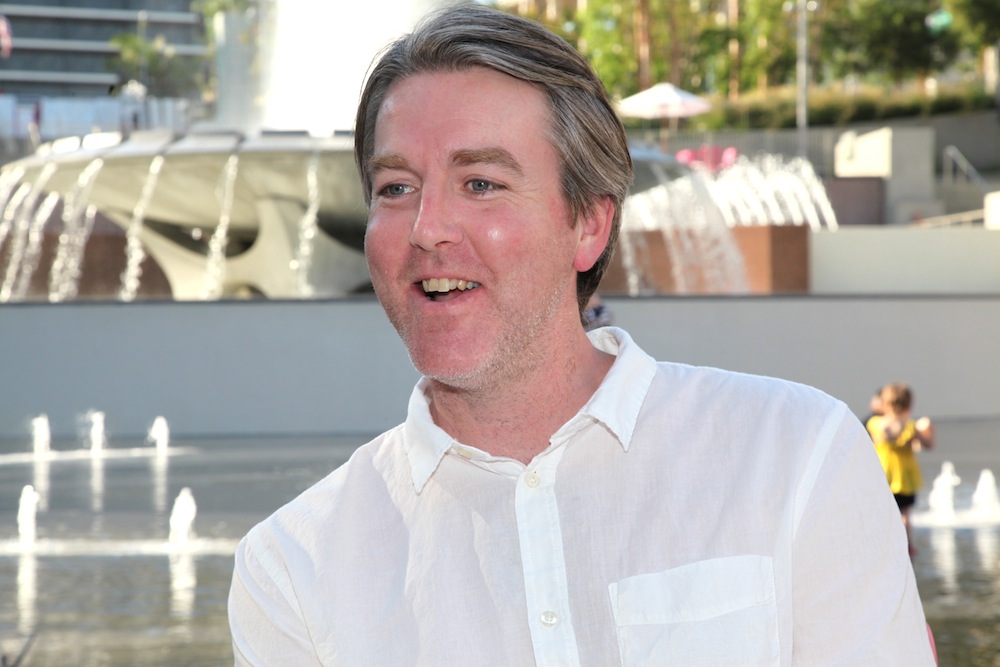
Christopher Hawthorne is the architecture critic for the Los Angeles Times. Before moderating a panel at Grand Park on the future of downtown Los Angeles, he pledged his loyalty to Peet’s coffee as a show of his Northern California roots, but called moving to L.A. the best decision he’s ever made in the Zócalo green room.
What is your favorite cartoon?
I don’t know if I have a favorite cartoon. Does Underdog count? It’s a ’70s TV show.
What L.A. building would you most like to see knocked down?
That’s a hard question for an architecture critic. A building would have to be so egregious for me to suggest knocking it down. Since we’re sitting here, I’m going to nominate the two county buildings on either side of us [the County Courthouse and Hall of Administration]. Doing that has certainly been discussed as a way of opening up the park and connecting it to the rest of downtown, and a way to make the park feel less hidden and really connected to the rest of Bunker Hill, Grand Avenue, and downtown.
How do you like your coffee?
I like it strong and preferably made by Peet’s—hometown loyalty since I grew up in North Berkeley.
What was the last thing that inspired you?
At the Venice Architecture Bienniale, one thing that inspired me was the final building designed by an Austrian architect named Raimund Abraham. He’s an architect who designed very few buildings in his lifetime and was killed in a car accident in downtown Los Angeles after giving a lecture at SCI-Arc. The building is now being completed in small artist colony in Düsseldorf. It’s an incredibly tough, difficult building in a lot of ways—made almost entirely of exposed concrete and really unforgiving. But it’s inspiring in how strong it is, and how true it is to his idea of art. That’s one of the reasons he did so few buildings—because he was so unwilling to compromise.
What’s your go-to karaoke song?
I have actually never done karaoke, shockingly enough.
What’s your current obsession?
The architecture of the late 1970s and early ’80s, which I think is really underappreciated, a lot of it.
What’s the best-designed restaurant in L.A.?
I don’t know if I’d call it the best-designed, but the place I take architects who come from out of town is Kate Mantilini on Wilshire in Beverly Hills. It’s an early design by Morphosis, Thom Mayne’s firm. And it’s just a really clear, strong example of the kind of work they were doing in that period—it’s really aggressive in a way. Architects, designers, critics from out of town—they always get a kick out of seeing it.
What’s your favorite road trip game?
I have two young kids, and we spend a lot of time going back and forth on the 5 to and from the Bay Area, so we play a lot of those. We’ve sort of gotten tired of the old standbys like 20 Questions and I Spy. We play a game where we quiz each other about whatever book we’re reading to the kids at the time, and we try to come up with questions about obscure characters in those books to see if we can stump our kids, and then they try to stump us. They always do better than we do.
What’s the best decision you’ve ever made?
That’s a profound question. I feel like I’m in therapy … Aside from getting married and deciding to have kids, I would say coming to L.A. It was not a city that I ever envisioned myself moving to, probably because I grew up in the Bay Area, and I was indoctrinated, like all Bay Area children, to dislike, or at least distrust Southern California. But I’m really glad that I decided to come down. It’s the most interesting, fascinating city in the country right now—certainly the most fascinating one to write about.
Whose talent would you most like to have?
Martin Amis’s talent for putting a paragraph together. I was just rereading Money, and it’s just—on the level of sentence by sentence, it’s incredibly intimidating to read.



